
Bernard Tuglamena Katexac
King Island, Alaska
Nome, Alaska
(1922 - 1997)

Katexac Biography
Bernard Katexac was born on King Island, a small point of rock off the Seward Peninsula - in 1922. He was the oldest of seven children. Bernard grew up in the traditional King Island Eskimo life, hunting seal and walrus in winter and traveling to Nome by skin boat each summer to live on the beach, fish and carve ivory. The King Islanders have settled in a permanent village at the edge of Nome, returning to their ancestral home only for the spring hunt.
Bernard attended the Bureau of Indian Affairs grade school on King Island and completed the eighth grade. He never went to high school. By the time he was 14, he head learned to carve ivory, partly by watching older carvers and partly through an elementary school carving program.
He moved to Nome in 1966. Shortly after his arrival, Bernard saw an article in the Nome Nugget describing a class in block printing. Bernard took the course. On the basis of this early work, the BIA awarded him a one-year BIA scholarship in art. At the University, Bernard explored a variety of art media and later branched out to take courses in social science and other areas. Dr. Charles Keim encouraged him to work for a degree and in 1970 Bernard graduated as a Vocational Associate of the Arts.
Bernard lived in Nome with several other members of family. He never married. Hunting and fishing was an important part of his life and he usually went out in the boats on the big spring hunt with the other King Island men. Although Bernard preferred to do etchings, the equipment was not available in Nome. Instead, he has become well-known in the area for his colorful woodblock prints of Arctic animals and Eskimo life.
August 2013
from the Sweeney collection

Seal and pup print - 66
January 2013
from the Sweeney collection
Kongit (Reindeer) (Qaglamina) (sp) Bernard Katexac - 64
March 2012
from the Sweeney collection

Grandmother Bernard Katexac
January 2012
from the Paul Harris collection



Ivory letter opener Bernard Katexac
September 2009
from the Sweeney collection

Woman skinning seal print# 11/75 - Bernard Katexac - 66
March 2009
from the Sweeney collection

Puiet sea travelers - artist proof Bernard Katexac, 1965
February 2008
from the Sweeney collection
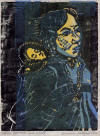
Mother and Child, print #24/60, Bernard Katexac, 1966
January 2007
from the Sweeney collection
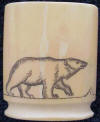
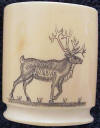

Ivory scrimshaw cup with a polar bear and reindeer by Bernard Katexac - 1973
March 2006
from the Bob and Nettie Nelson collection
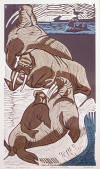
Walrus on migration, of 800 lithographs
Nome was battered by a severe storm in 1972, which came in off the Bering Sea with waves that crashed over the sea wall and sent walls of water cascading down Front Street. Damage to everything on the ocean side of the street was extensive. The town library, which was in the basement of one of the buildings on the southern end of town, was flooded. The run of 800 lithographed prints of this woodcut was authorized as a fundraiser for the library. - Bob & Nettie Nelson
Walrus on Migration
A reproduction from Original Wood Blocks by Bernard Katexac
The walrus is one of the largest and most important mammals living in Alaskan waters. A large male may weigh one and a half tons. Walrus live at the edge of the polar ice pack. They stick to shallow water where they can easily dive to the bottom to feed on fish, shellfish and other creatures of the seabed. Each fall they move south through the Bering Straits in family groups ahead of the polar pack ice and in April or May they move north again following leads (openings)in the sea ice. The young are born in May during the northward migration. They remain with their mothers until their tusks grow long enough to dig up food, about two years. Walrus are sociable animals with a strong community spirit. They will go to the aid of a wounded fellow rather than flee to safety.
The Eskimos of Alaska's western Bering Sea coast have long depended on the walrus for a major part of their livelihood. Nothing is wasted. The meat provides food; the hide is used for boat coverings, for rope and for mukluk (fur boots) soles. Rain parkas are made from the intestines; food storage bags and drum heads come from the stomach, thread from the sinews. The bones are fashioned into tools and weapons and ivory tusks provide one of the traditional Eskimo art mediums
Bernard has chosen to show a walrus family resting on an ice flow during one of the migration periods. The print is made with the understanding and respect of a man who knows his own well-being is linked to the welfare of the animal he hunts. It is an affirmation of life which renews itself even in the icy Arctic waters
unknown author
January 2005
from the F. Richard Miller collection

Tutut (caribou) print# 7/15, Bernard Katexac, 1964
September 2005
from the Sweeney collection


Cutting walrus hide print# 42/46 - Bernard Katexac - 1966
Husky pups print 2nd ED # 11/20 - Bernard Katexac - 1970
formerly of the collection of Brent & Kathleen Enterline Sun Prairie, WI


Cutting whale hide print# 2/35 - Bernard Katexac - 1966
Tufted puffins print# 3/30 - Bernard Katexac - 1966
from the Sweeney collection
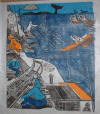
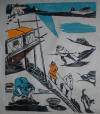
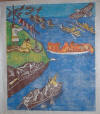

Arctic I print#24/30 - Bernard Katexac - 1977
Arctic II print# 8/30 - Bernard Katexac - 1977
Arctic III print# 12/30- Bernard Katexac - 1977
Arctic IV print# 12/30 - Bernard Katexac - 1977
from the Sweeney collection


Cutting whale hide print# 2/35 - Bernard Katexac - 1966
Tufted puffins print# 3/30 - Bernard Katexac - 1966
A list of known Bernard Katexac prints:
Know of a print we don't have listed, please contact us
- "Avik" 1963
- "Ezakvalik" translation Walrus with Baby 1963
- "Nanuk Niak Toac" 1963
- "Ukiu Vok Miut II" - King Island Village 1963
- "Woman Skinning Seal" 1963
- "Akiak" (mother and child) 1964
- "Tutut" (caribou) 1964
- "Kongit" (reindeer) 1964
- "Cliff Dwellers" 1965
- "Model" 1965
- "Wood-Skin Houses, King Island" 1965
- "Wood-Skin Houses, King Island" 1965
- "Cutting Walrus Hide" 1966
- "Fishing through ice" 1966
- "Kayaker in River" 1966
- "Mother and child" 1966
- "Nomad's Scrimshaw" 1966
- "Rookery" 1966
- "Walrus and Calf" 1966
- "Woman and Child" 1966
- "Woman skinning seal" 1966
- "Shadows in a pond" 1969
- "Walrus" 1969
- "Launching Whaleboats" 1970
- "Old Ivory Etching" 1970
- "Pup Huskies" 1970
- "Shadows in the Pond" 1970
- "Girl with a Sheefish" 1972
- "Walrus on Migration" 1972
- (also reproduced as lithograph - 800)
- "Saggy Movement" 1973
- "One Chance" 1974
- "Mixed Eiders" 1975
- "Season in the Arctic I" 1977
- "Season in the Arctic II" 1977
- "Season in the Arctic III" 1977
- "Season in the Arctic IV" 1977
- "Grandmother" 19??
- "Tupkit" (Wood-skin houses) King Island 19??